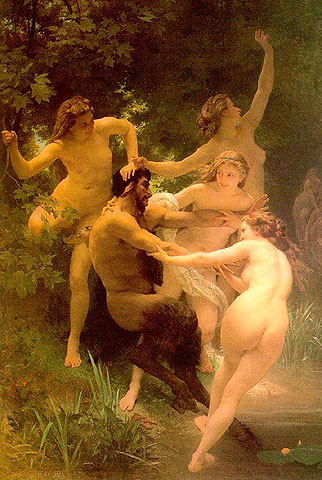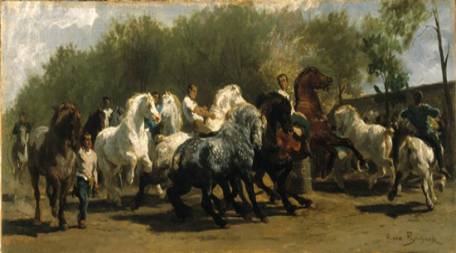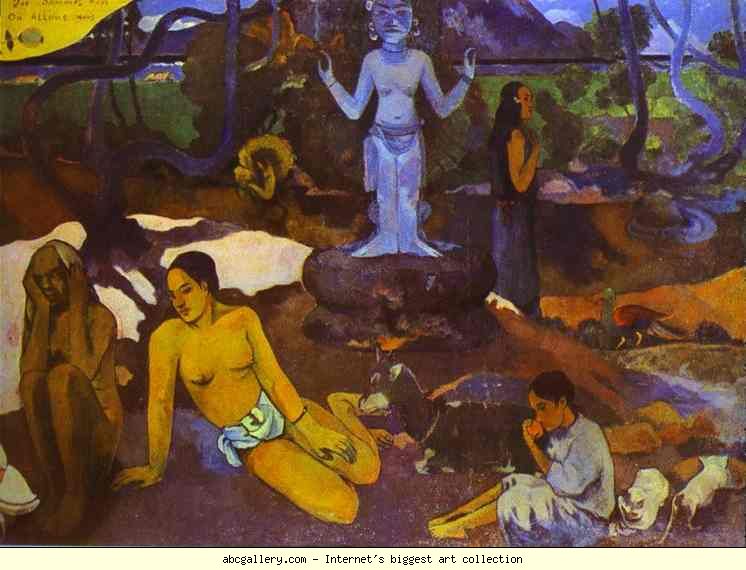Skip to comments.
Art Appreciation/Education series II class #5: Neoclassical and Romantic Art
5/11/06
| republicanprofessor
Posted on 05/11/2006 3:04:49 PM PDT by Republicanprofessor
click here to read article
Navigation: use the links below to view more comments.
first previous 1-20, 21-40, 41-59 last
To: TradicalRC
The interesting thing about Bougereau is that he was pretty much ignored until the feminist movement of the 1970s. Then the feminists reappraised the reputation of Rosa Bonheur, and then, with that, many of the other academic painters.


Bougereau Nymphs and Satyr (your favorite!) and Bonheur's Horse Fair
I'll still take the Guernica you posted over most Ingres and any Bougereau any time. However, Ingres' portraits are still stunning (and less distorted than his other nudes).

Ingres Mme. Riviere
To: Republicanprofessor
Poussin's St. John on Patmos Island. But now I'm putting a Cezanne of Mt. Ste. Victoire next to the Poussin; maybe you can see how the balance is similar, even if Cezanne has brighter colors and is more abstract. (Yeah, now I don't think you'll like Cezanne much; am I right?!) You know me well. I stand corrected, The cezane doesn't do it for me at all. Too cartoonish.
Liberty. This is just a detail, but it focuses on what your interest was.
Now I'll admit to liking nude ladies as much as the next guy but the problem here is that she just doesn't fit. So it's not so much that my interest in nude ladies overwhelmed the painting, it's that a nude lady in the middle of a battle offends my sense of logic and consistency. Somewhat like how one obnoxiously sour note destroys a whole performance of good music. I get annoyed at continuity errors in film also
42
posted on
05/12/2006 7:09:41 AM PDT
by
John O
(God Save America (Please))
To: TradicalRC
Is that done in paint or inks/pencil. That's not a photo right? That guy is good. While I couldn't hang it over the sofa it is a work of beauty. great realism.
43
posted on
05/12/2006 7:11:49 AM PDT
by
John O
(God Save America (Please))
To: Sam Cree
In any case, my opinion is that Prud'hon had a lot greater appreciation of the female (and male) form that some of these other guys. I agree. What is he working in to get such perfect image
44
posted on
05/12/2006 7:14:08 AM PDT
by
John O
(God Save America (Please))
To: Republicanprofessor
Now I like the Bougereau Nymphs and Satyr because it looks real. Even unreal things can be painted as real.
Ingres Mme. Riviere. A very pretty portrait. Oddly enough though her face is the week point of it. Everything else looks wondeful, rich and luxurious but her face looks dead(?). No spark, no fire in it. Contrast that to the central nymph in the other painting. Life, interest, passion, a sparkle in her eyes. She looks alive.
45
posted on
05/12/2006 7:25:39 AM PDT
by
John O
(God Save America (Please))
To: Republicanprofessor; TradicalRC; John O
RP, I don't know what the feminists may think of Bouguereau, or necessarily care, but the nude ladies in his paintings look like they could step right out of the paintings and walk across the room. That quality of *life,* which is present, IMO, in all his work is what, in my mind, makes his stuff transcend the somewhat silly or sentimental subject matter he used.
There aren't too many painters who do that, make the figures look so alive. Another who does, worlds apart, is Anthony Van Dyke.
46
posted on
05/12/2006 7:37:03 AM PDT
by
Sam Cree
(Delicacy, precision, force)
To: John O
***"What is he working in to get such perfect image?"***
Who knows? There is some theorizing going on here, very interesting site:
http://www.art.net/~rebecca/OnPrudon7a.html
Black and white chalk is a good guess IMO, maybe charcoal as well.
47
posted on
05/12/2006 7:42:58 AM PDT
by
Sam Cree
(Delicacy, precision, force)
To: John O
48
posted on
05/12/2006 7:45:56 AM PDT
by
TradicalRC
("...this present Constitution, which will be valid henceforth, now, and forever..."-Pope St. Pius V)
To: Republicanprofessor
It is definitely time to finish my series of art “lectures.”Please don't finish. Keep 'em coming! I've enjoyed and truly appreciate your beautiful, elevating lessons. Thank you.
To: Republicanprofessor
Thank you for posting your essays.
Through 4 years of HS art and 3 years of art school I never was offered an Art History class. It wasn't until college that I was first exposed to actually placing art in the context of the time it was created, and learning how it both reflected and shaped the contemporary world. Every artist came alive for me then, as I grew to know them more deeply a thumbnail sketch. What a shame it took so long in the educational process!
50
posted on
05/12/2006 9:41:02 AM PDT
by
Sisku Hanne
(Equal treatment for illegal aliens: the US should adopt Mexico's immigration policy!)
To: Sisku Hanne
I don't understand the intellectual split in art schools (and large universities) between art history and studio art. To me, they enlighten and inspire each other.
But quite often the art profs don't talk to the art historians and vice versa. I guess it's a territorial thing. I just don't understand. Thank goodness, in our department, our profs teach both art history and studio art and integrate them often in their classes. And we are always learning in the process.
To: fullchroma
Please don't finish. Keep 'em coming! I've enjoyed and truly appreciate your beautiful, elevating lessons. I won't stop writing when inspired. In fact, I welcome suggestions for art-themed posts for the future. (Someone suggested portraits in the past....) But the basic history of art "course" has finally been completed.
To: Republicanprofessor
"I don't understand the intellectual split in art schools (and large universities) between art history and studio art. To me, they enlighten and inspire each other." The Art History profs are concerned with art and the studio profs are not?
53
posted on
05/12/2006 11:05:05 AM PDT
by
Sam Cree
(Delicacy, precision, force)
To: Republicanprofessor
Art profs are concerned with progressivism, what's new and the cutting edge, Art history profs are concerned with tradition, what's happened, and what we've learned.

54
posted on
05/12/2006 1:54:32 PM PDT
by
TradicalRC
("...this present Constitution, which will be valid henceforth, now, and forever..."-Pope St. Pius V)
To: Republicanprofessor
You are one of the best things on FR!
To: TradicalRC
I think Goethe posited that all art goes through three natural stages: classic, romantic and decadent and moves on to another form of classic that starts the process all over again, ever run across this?I missed this comment earlier....sorry.
I'm also sorry to say that I'm not up on my German Romantic writers and philosophers. (I find German philosophy unbearably heavy....) I do see art as a cycle, but I would not use the word decadent. I do see a development from simple and primitive (Greek Archaic Art, early Medieval art), to more dignified realism (the Greek Classical style, the Renaissance, Neoclassicism) and then to exaggerated movement (the Hellenistic, the Baroque, and Romanticism).
But I do think the possibilities for art changed dramatically (and opened up amazingly) with the development of the camera. So I see the development of abstraction beginning more simply (Cubism) and then becoming more wildly energetic (Pollock). Then the pendulum swings back to simplicity with Minimalism.
Actually, what I think will happen is a development of many different kinds of abstraction in the next century. Giotto was the primitive of realism that developed into the Renaissance, and I think Cezanne will be seen as the same for abstraction. Artists will be free to pick from and develop abstraction to a new level of richness and meaning in the next century.
I guess you still might call that idea decadent. We are free to disagree.
To: Paved Paradise; Pharmboy
You are too kind, and I thank you from the bottom of my heart for making my day (and week and....)!
To: TradicalRC
>>>
Have you been reading Jasper Fforde's The Eyre Affair?
<<<
No, but I have been reading FreeRepublic :)
(but Fforde's book looks interesting).
58
posted on
05/12/2006 4:42:29 PM PDT
by
evilC
(Call me Krusty)
To: Republicanprofessor
I do see art as a cycle, but I would not use the word decadent. I think decadent has become a loaded term, but then perhaps it has earned its reputation. IIRC, the classic phase was marked by clean lines, clear, straightforward forms, austere, reserved and was art in its healthy, young, innocent stage. Think late Spring/early Summer.
The romantic phase was marked as ornate, florid, fanciful, assymetrical and was art in full bloom, Think late Summer.
The decadent phase is marked by exaggerated romanticism, caricaturish, a garden overgrown with ivy, the dissolution of forms, often vulgar and sickly. Late fall, leaves brown and falling off of skeletal trees.
But I do think the possibilities for art changed dramatically (and opened up amazingly) with the development of the camera. So I see the development of abstraction beginning more simply (Cubism) and then becoming more wildly energetic (Pollock). Then the pendulum swings back to simplicity with Minimalism.
I think the development of the camera has been overrated. The camera can produce abstraction just as well as realism. It's effect on painting seems roughly the equivalent of the typewriters effect on the pen.
59
posted on
05/12/2006 8:35:50 PM PDT
by
TradicalRC
("...this present Constitution, which will be valid henceforth, now, and forever..."-Pope St. Pius V)
Navigation: use the links below to view more comments.
first previous 1-20, 21-40, 41-59 last
Disclaimer:
Opinions posted on Free Republic are those of the individual
posters and do not necessarily represent the opinion of Free Republic or its
management. All materials posted herein are protected by copyright law and the
exemption for fair use of copyrighted works.
FreeRepublic.com is powered by software copyright 2000-2008 John Robinson


